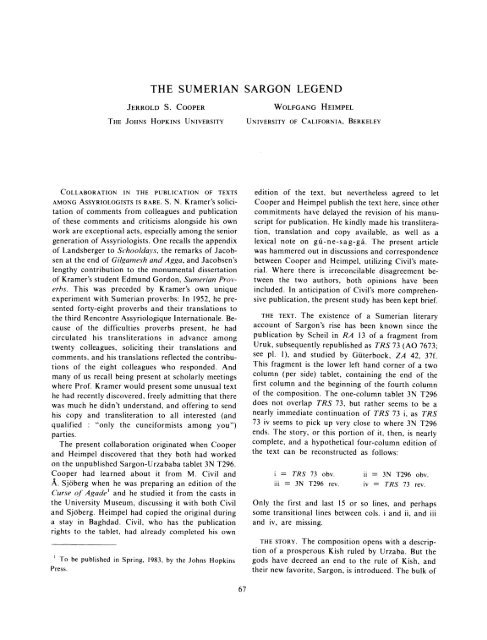The Sumerian Sargon Legend
The Sumerian Sargon Legend
The Sumerian Sargon Legend
You also want an ePaper? Increase the reach of your titles
YUMPU automatically turns print PDFs into web optimized ePapers that Google loves.
THE SUMERIAN SARGON LEGEND<br />
JERROLD S. COOPER WOLFGANG HEIMPEL<br />
THE JOHNS HOPKINS UNIVERSITY UNIVERSITY OF CALIFORNIA, BERKELEY<br />
COLLABORATION IN THE PUBLICATION OF TEXTS<br />
AMONG ASSYRIOLOGISTS IS RARE. S. N. Kramer's solicitation<br />
of comments from colleagues and publication<br />
of these comments and criticisms alongside his own<br />
work are exceptional acts, especially among the senior<br />
generation of Assyriologists. One recalls the appendix<br />
of Landsberger to Schooldai's, the remarks of Jacobsen<br />
at the end of Gilgamesh and Agga, and Jacobsen's<br />
lengthy contribution to the monumental dissertation<br />
of Kramer's student Edmund Gordon, <strong>Sumerian</strong> Proverbs.<br />
This was preceded by Kramer's own unique<br />
experiment with <strong>Sumerian</strong> proverbs: In 1952, he presented<br />
forty-eight proverbs and their translations to<br />
the third Rencontre Assyriologique Internationale. Because<br />
of the difficulties proverbs present, he had<br />
circulated his transliterations in advance among<br />
twenty colleagues, soliciting their translations and<br />
comments, and his translations reflected the contributions<br />
of the eight colleagues who responded. And<br />
many of us recall being present at scholarly meetings<br />
where Prof. Kramer would present some unusual text<br />
he had recently discovered, freely admitting that there<br />
was much he didn't understand, and offering to send<br />
his copy and transliteration to all interested (and<br />
qualified: "only the cuneiformists among you")<br />
parties.<br />
<strong>The</strong> present collaboration originated when Cooper<br />
and Heimpel discovered that they both had worked<br />
on the unpublished <strong>Sargon</strong>-Urzababa tablet 3N T296.<br />
Cooper had learned about it from M. Civil and<br />
A. Sjdberg when he was preparing an edition of the<br />
Curse of Agade' and he studied it from the casts in<br />
the University Museum, discussing it with both Civil<br />
and Sjdberg. Heimpel had copied the original during<br />
a stay in Baghdad. Civil, who has the publication<br />
rights to the tablet, had already completed his own<br />
l To be published in Spring, 1983, by the Johns Hopkins<br />
Press.<br />
67<br />
edition of the text, but nevertheless agreed to let<br />
Cooper and Heimpel publish the text here, since other<br />
commitments have delayed the revision of his manu-<br />
script for publication. He kindly made his translitera-<br />
tion, translation and copy available, as well as a<br />
lexical note on g6-ne-sag-gd. <strong>The</strong> present article<br />
was hammered out in discussions and correspondence<br />
between Cooper and Heimpel, utilizing Civil's mate-<br />
rial. Where there is irreconcilable disagreement be-<br />
tween the two authors, both opinions have been<br />
included. In anticipation of Civil's more comprehen-<br />
sive publication, the present study has been kept brief.<br />
THE TEXT. <strong>The</strong> existence of a <strong>Sumerian</strong> literary<br />
account of <strong>Sargon</strong>'s rise has been known since the<br />
publication by Scheil in RA 13 of a fragment from<br />
Uruk, subsequently republished as TRS 73 (AO 7673;<br />
see pl. 1), and studied by Guterbock, ZA 42, 37f.<br />
This fragment is the lower left hand corner of a two<br />
column (per side) tablet, containing the end of the<br />
first column and the beginning of the fourth column<br />
of the composition. <strong>The</strong> one-column tablet 3N T296<br />
does not overlap TRS 73, but rather seems to be a<br />
nearly immediate continuation of TRS 73 i, as TRS<br />
73 iv seems to pick up very close to where 3N T296<br />
ends. <strong>The</strong> story, or this portion of it, then, is nearly<br />
complete, and a hypothetical four-column edition of<br />
the text can be reconstructed as follows:<br />
i = TRS 73 obv. ii = 3N T296 obv.<br />
iii = 3N T296 rev. iv = TRS 73 rev.<br />
Only the first and last 15 or so lines, and perhaps<br />
some transitional lines between cols. i and ii, and iii<br />
and iv, are missing.<br />
THE STORY. <strong>The</strong> composition opens with a descrip-<br />
tion of a prosperous Kish ruled by Urzaba. But the<br />
gods have decreed an end to the rule of Kish, and<br />
their new favorite, <strong>Sargon</strong>, is introduced. <strong>The</strong> bulk of


